We’ve created the perfect Japan packing list that has the essentials (many of which you might not think about) and what you should NOT pack for a trip to Japan. We’re also sharing what to wear in Japan for all seasons as well as tons of practical tips!
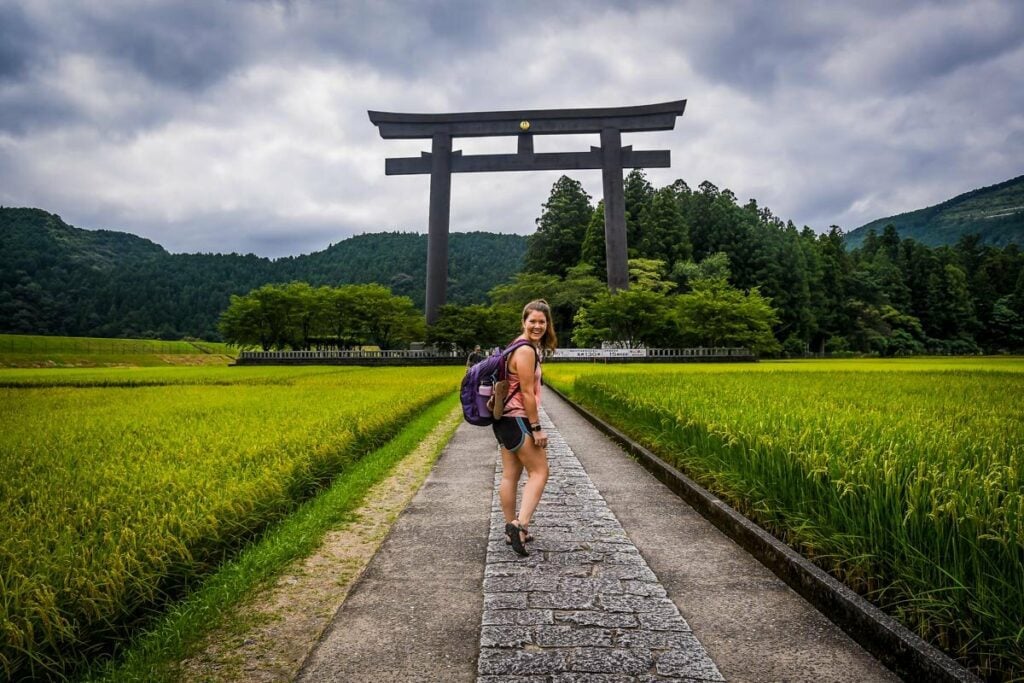
Determining what to pack for a trip to Japan can be overwhelming.
We know because we’ve traveled to Japan several times and understand that you want to have all the essentials without overpacking. Striking that balance can be tough, even for the most seasoned of travelers.
We’ve created a Japan packing list with all the items you should definitely bring. Some of these items are specific to Japan travel and I bet there are some things on this list you haven’t even thought of!
We’re also sharing packing tips we’ve learned after several trips to Japan as well as what NOT to bring.
Psst! Before we dive in, I want to mention that we created a Japan packing checklist that you can download (totally free!) so you’re sure you don’t forget anything. It has everything on this list and more, so don’t forget to grab your copy!
Japan Packing Guide
1. Passport
You might be saying duh, but you’ll want to triple check that you have your passport packed before leaving for the airport!
Insider tip: We like keeping our passports in a cover (like this one) so that we can keep arrival documents and important business cards together.
2. Japan Rail Pass
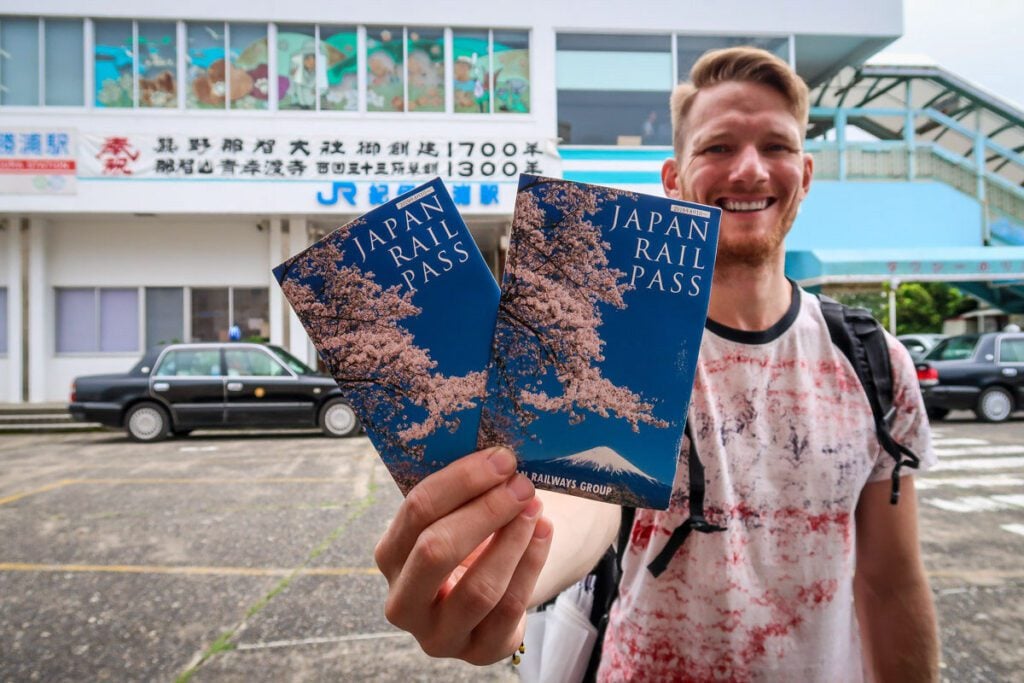
If you choose to get a Japan Rail Pass for your trip, you will need to have the physical copy packed with you.
Important: You cannot get the Japan Rail Pass inside Japan, so it needs to be delivered to you before your trip.
Wondering if the Japan Rail Pass is worth it for your trip?
In short, there was a huge price increase in late 2023, so while it used to save just about every traveler a lot of money, these days it won’t make sense for many travelers. This J-Rail guide goes over all the details so you can decide if it will save you money or not.
3. Travel Insurance
Just as with any trip, you will definitely want to get travel insurance.
Japan is an especially important destination to get an insurance policy for since accommodation and flights are generally on the more expensive side. You want to be sure you’re covered in case of an emergency.
We have an entire guide that goes over how to choose the best policy for you in detail.
Our personal advice: We recommend getting your insurance policy as soon as you start making your accommodation and flight bookings.
4. Credit cards
You will absolutely use credit cards in Japan. But before you pack your entire wallet, here are some things to consider:
- Choose cards with zero foreign transaction fees
- Bring at least 2-3 credit cards so you have back ups in case one doesn’t work
- Visa cards are notorious for not working in much of Japan (ours worked sometimes but not all the time)
- We had good luck with American Express and MasterCard
- Bring a debit card that reimburses all ATM fees so you can withdraw Japanese yen at the best rates
- Our personal recommendation: We’ve been using a Charles Schwab debit card for this reason since 2014 and we absolutely love it!
→ Read more about our personal credit card recommendations!
5. Japanese yen
(optional)
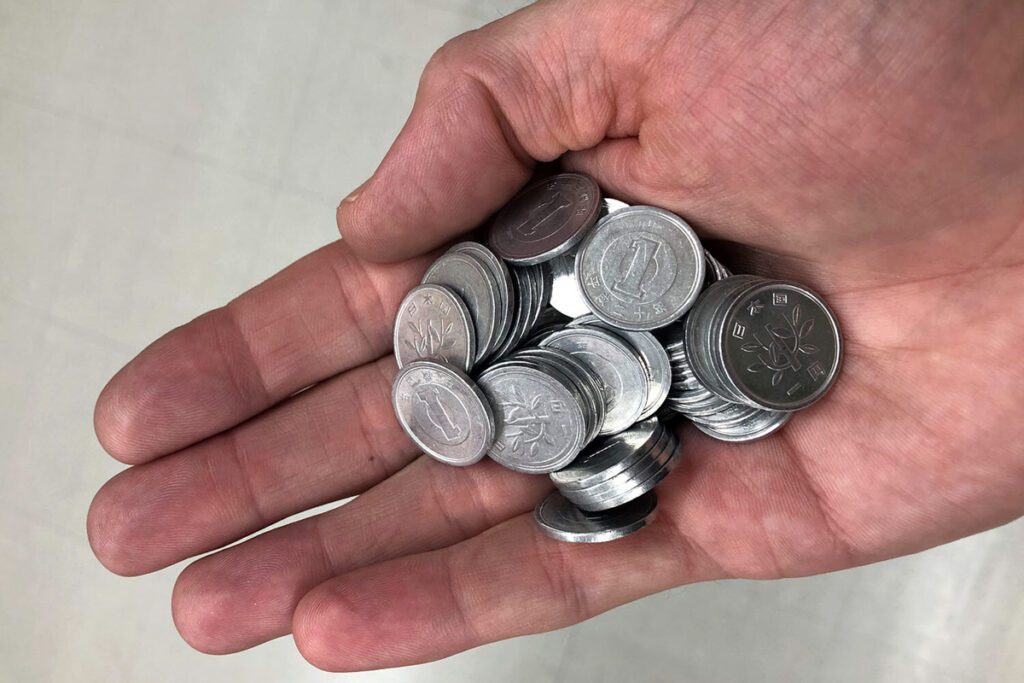
First things first: You will 100% need Japanese yen on your trip in Japan. While much of the country operates with credit cards and electronic payment systems, there are still lots of small shops or attractions that only take cash.
That said, we personally never get cash at home for our trips. (We haven’t since 2014.) This is because when you get foreign currency from your home bank, you pay a commission fee.
To avoid this and to get the best rate on foreign currency (no matter where in the world we are), this is what we do instead:
- Immediately after landing and getting our luggage, we find an ATM. Airport arrivals areas always have them. Note: Do NOT go to a currency exchange counter because they charge commission. ATMs give you the best exchange rate.
- We withdraw as much cash as we’d like using our Charles Schwab debit card (which reimburses all ATM fees). Note: Since we get the best rate and do not pay any ATM fees, we don’t feel the need to withdraw large sums at a time. We simply get as much as we need for the next couple of days so we’re not traveling with tons of cash.
Good to know: Getting a small amount of Japanese yen from your home bank isn’t a bad idea if it makes you more comfortable. However, after many years of traveling and crunching the numbers, we feel that going directly to an ATM after landing (with the right card) is the best way to get currency.
6. Coin purse
(optional)

It’s worth pointing out that in Japan, many coins are worth large sums of money. For example, the ¥100 coin is worth roughly $0.70 and the ¥500 coin is worth more than $3.
You will wind up with way more coins than you’re used to – trust me! Since they’re worth a lot, you don’t want to lose them in the bottom of your bag or your pocket.
A small zipped coin bag is a must, in our opinion!
If you don’t have one at home, you can plan to buy one in Japan as they are a popular Japanese souvenir. Just be warned that they can get quite expensive! We looked around for several days before we found one that was under $10.
If you want to get one before your trip, this one is simple and inexpensive.
7. Luggage
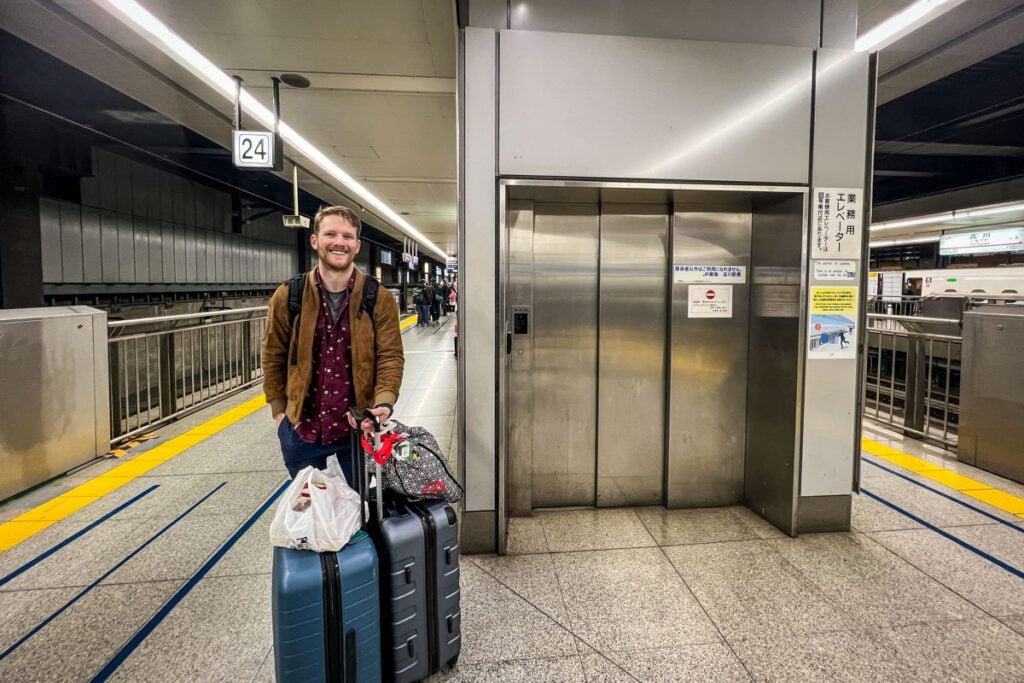
Put some thought into what type of bag you will travel with in Japan.
Most Japanese travelers have hard-sided suitcases, so if you don’t want to stand out this can be a good option.
Our personal experience: We’ve traveled in Japan with both backpacks and suitcases, and each has its perks. Carrying suitcases up and down stairs at train stations is not fun. But getting on a crowded train with a large backpack can be cumbersome and make you stick out.
Our recommendation: On our most recent trip to Japan, we packed our belongings in our Away suitcase (size: “The Medium”). It worked really well, I would just advise you not to choose the largest size. It will be very difficult to move around with, especially in crowded areas.
→ Psst! We’re settling the age old debate: whether to travel with a backpack or suitcase? In our article, we break down the pros and cons of each to help you decide!
8. Capsule wardrobe

When packing clothes, we recommend thinking about them as a capsule wardrobe. That way, you can create lots of different outfits using some of the same items.
This will ensure you’re prepared for all different weather and occasions without overpacking.
Thinking about what to wear in Japan can be a little overwhelming – we’ve been there! We actually created a whole guide to what clothes to pack for Japan (plus, what not to wear!) to make it easier.
9. Packing cubes
We’re big fans of packing cubes no matter what type of trip we’re going on. We’ve tried a lot of brands, but this is our favorite.
Not only do they help keep our things organized, but they compress your clothes a bit, giving you a more efficiently-packed suitcase.
→ Related: Pack like a pro every time with our expert packing hacks!
10. WiFi device or SIM card
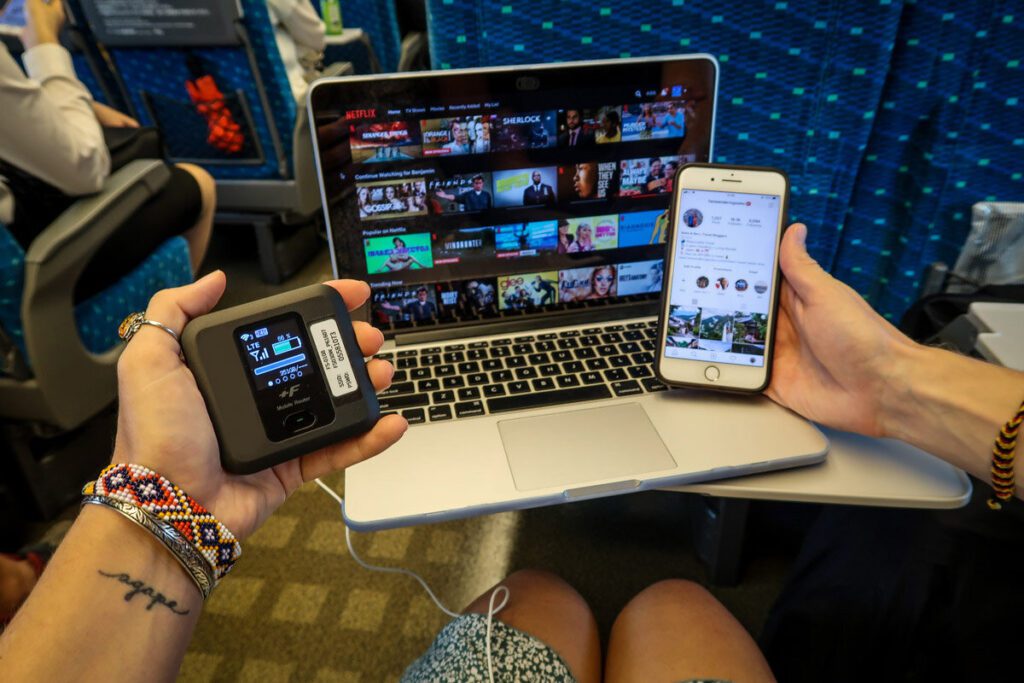
Trust me when I say you will need access to the Internet in Japan for translating menus, getting directions, and looking up random words.
Before your trip to Japan, determine how you will get Internet access. The two most popular ways are either with a WiFi hotspot device or through an eSIM.
They each have benefits, so we created a guide to choosing between a WiFi device and a SIM card that should help make this decision easier!
Whichever you choose, you must set it up before your trip, so don’t forget about it when you’re packing.
11. Virtual Suica, ICOCA, or Pasmo card
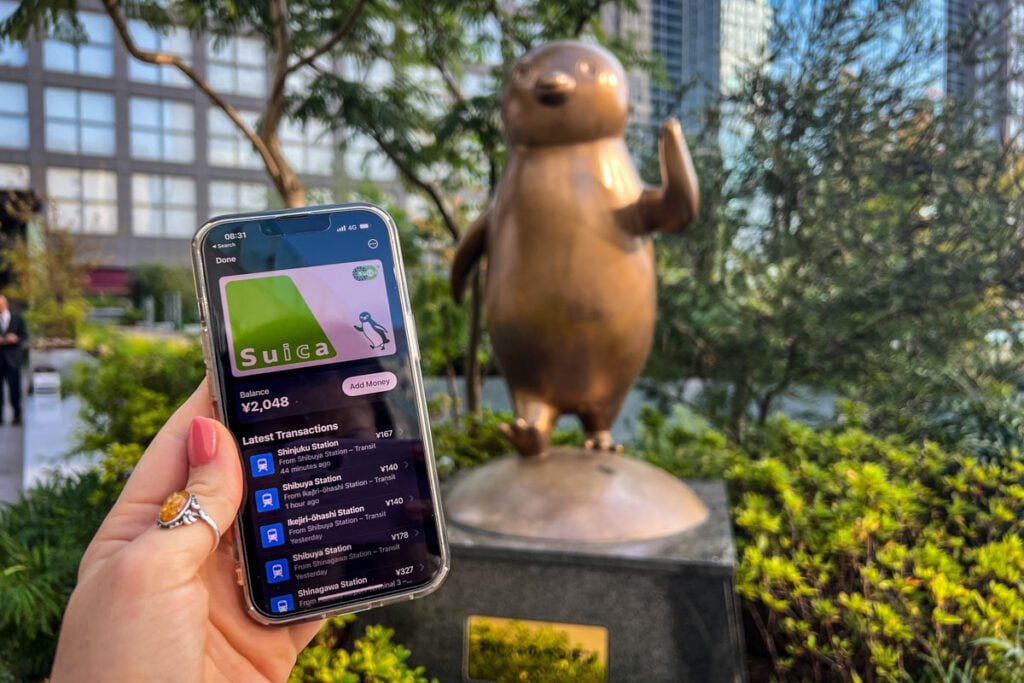
Let me first explain what these are:
Suica, ICOCA, and Pasmo are all public transit cards in Japan. These work on the Tokyo subway and bus systems as well as in many big cities around Japan.
In the past, they each had slightly different coverage areas. However, today, they are more or less identical so it really doesn’t matter which one you choose.
These used to be physical cards that you could purchase once you arrived in Japan (usually inside a konbini, or convenience store). Today, this is also a virtual card that you can load onto your phone’s wallet.
It is incredibly convenient because you can simply tap your phone on the turnstile and the app will seamlessly track your ride. This eliminates the need to use a machine to purchase a ticket and then slip said ticket into the proper slot.
It is much easier, takes less time, and won’t hold up a line behind you. Trust me, you need this.
Good to know: You don’t even need to open the wallet on your phone before tapping. Your balance will show up in a notification so you know when you’re running low. You can easily top off from your phone.
We recommend getting a virtual transit card before your trip. That way, you can hop on public transportation immediately upon arrival (aka the cheapest and easiest way to get around).
How to get a Suica card:
- Simply open the “wallet” on your phone and search for one of these transit cards. Personal experience: We personally got Suica, but any will do. (In the past, we’ve used a physical ICOCA card.)
- Connect a credit card to the app. In our experience, our Visa cards did not work (FYI Visa often doesn’t work in Japan). Our American Express cards worked fine.
- Select an amount of money you’d like to add to the virtual card. You can always see your balance and it is easy to top off, so don’t worry too much about the amount.
- Everyone in your travel group needs to have their own virtual card loaded in their phone.
Traveling with kids? Children 6 and under ride the subways for free. If you are traveling with a child who does not have a phone, you’ll need to purchase a physical card (from a convenience store in Japan) that they can tap. There is a child rate for kids 7-11 years old, while 12 and up is the adult fare.
→ Psst! Planning a family trip to Japan? Here’s everything we wish we knew before going with our toddler in tow!
12. Apps for Japan

Before your trip, be sure to download a few key apps to your phone so they’re ready to go when you arrive. This way, you won’t use up data or have to connect to WiFi in order to use them.
We have a round up of the best Japan travel apps, but here are 2 you will definitely use:
- Google Translate (download the Japanese language pack)
- GlobeConvert: convert prices in Japanese yen into your home currency with real time exchange rates
13. Universal outlet adapter
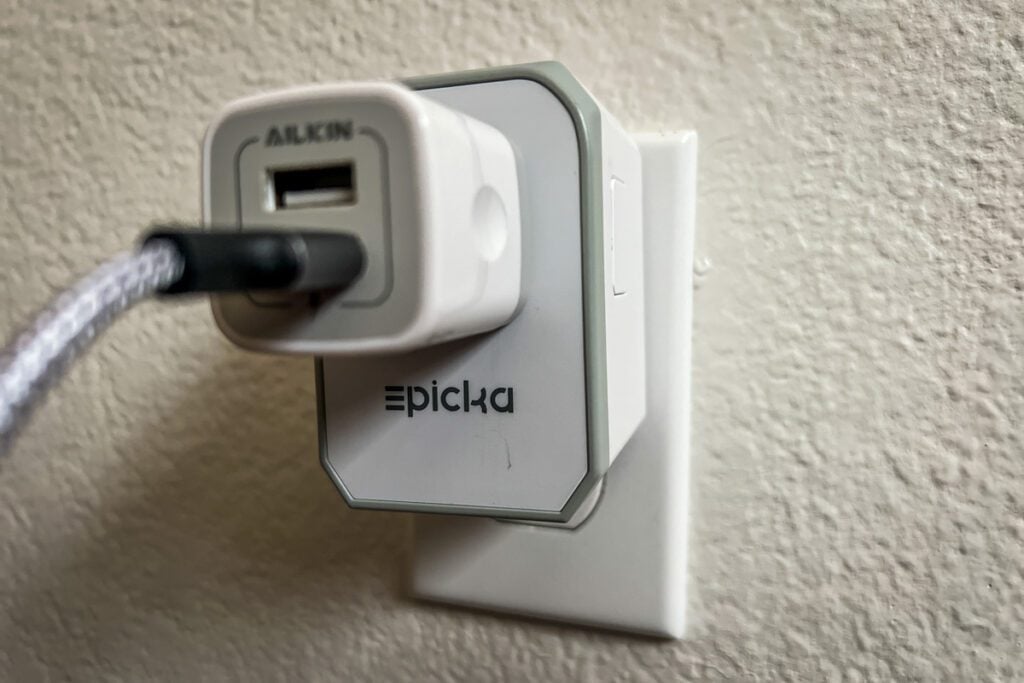
You will want to make sure you have the correct outlet adapter so that you can charge your electronics while traveling in Japan.
Japan has a similar outlet plug to North America (see what it looks like here). But you may need an adapter for some of your devices with three prongs.
We personally use this adapter. It has options for countries all over the world, making packing super simple no matter where we’re going.
It also has several USB ports so you can charge multiple devices at the same time.
Do I need a converter?
I always used to get adapters and converters mixed up. So let’s first get clear on the difference between them:
- Adapter: a device that changes the plug design so it fits in the outlet of the country you’re visiting
- Converter: changes the voltage of the device you are charging so that it doesn’t damage the components
Many large electronics have a built-in converter these days. Things like laptops have this integrated into the charging cord, so you won’t need to worry about plugging it in.
Items that you may need a converter for are hair devices (like a hair dryer), or electronic toothbrushes.
Insider Tip: If you use a hair straightener or curling iron, we recommend choosing one made for travel (like this one) because it is compact and also adapts to the country’s voltage without a converter.
We personally don’t travel with converters very often anymore. The only device we’d need it for is our electric toothbrushes. They last for about 2-3 weeks on one charge, so we usually just go without charging it on our travels. However, whether you choose to bring a converter or not is a personal choice. It will depend on what electronics you plan on packing.
14. Power bank
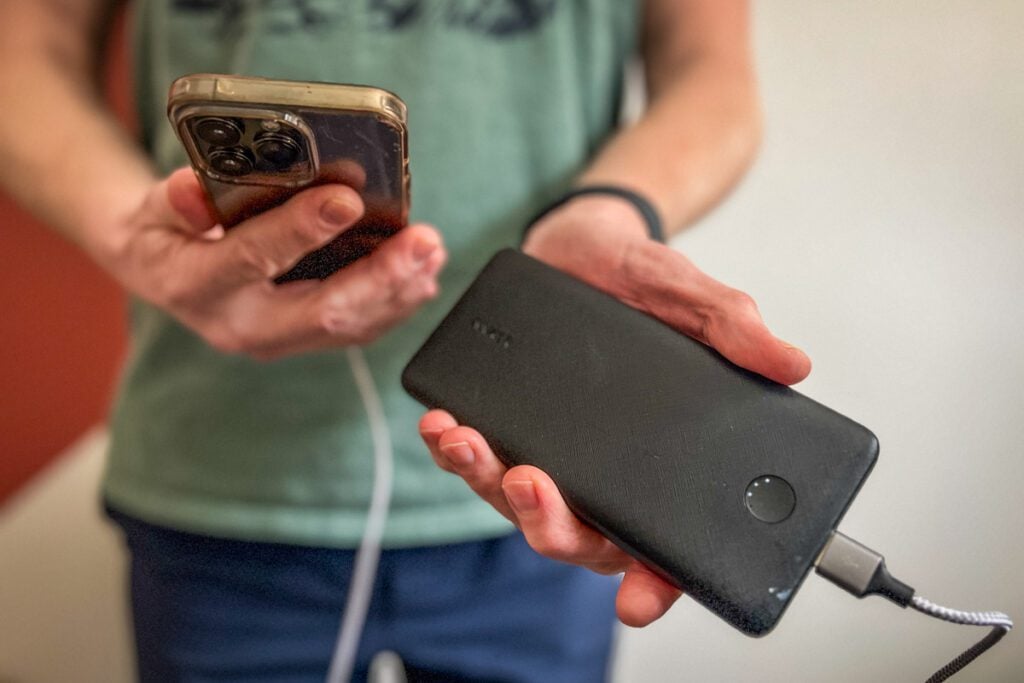
While traveling in Japan, you’ll likely be out exploring for most of the day. This means you’ll be far away from your hotel and any place to charge your phone (or other electronics).
Don’t let it die! Pack a portable power bank so you can recharge on the go.
We’ve been traveling with this exact power bank for years (since 2015!). It’s on the heavier side as far as power banks go. But we love that it has the capability to charge our phones multiple times before needing to be charged itself.
15. Comfortable shoes
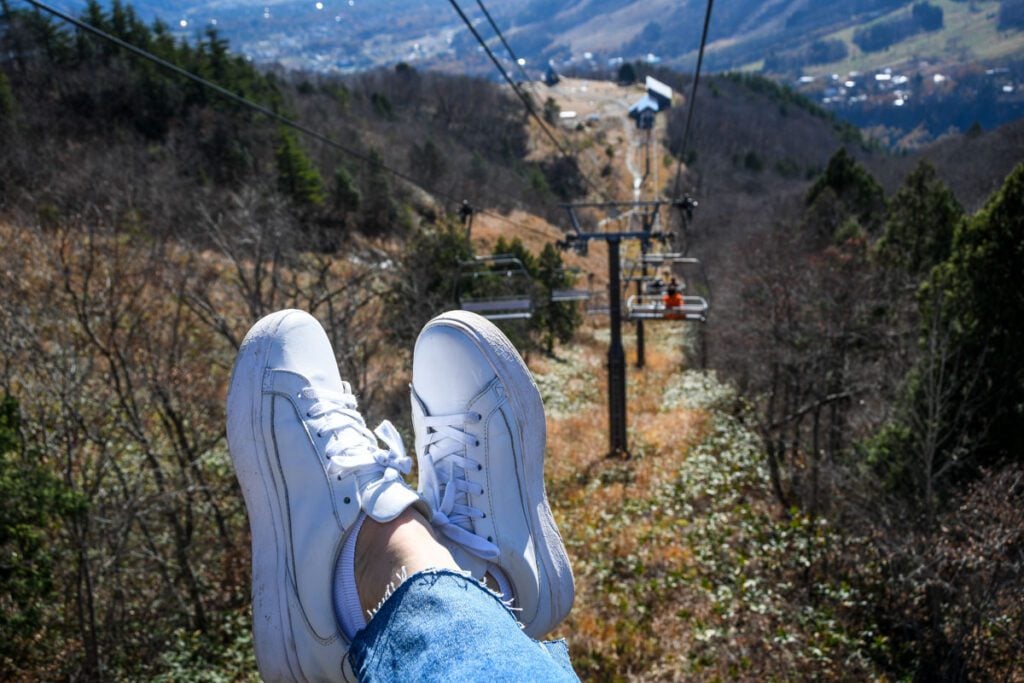
There are few other places in the world where we’ve walked as much per day as we have in Japan. You will definitely want to bring shoes that are comfortable, and break them in before your trip.
In addition to being comfortable, I’d highly recommend you choose shoes that come on and off easily. While traveling in Japan, you will need to take your shoes on and off often, when you enter some restaurants, in ryokans, in anyone’s home, inside temples and shrines… you’ll be doing this multiple times per day, so avoid shoes that are difficult to get on and off.
Personal recommendation:
Before our most recent trip to Japan, we both splurged on Kizik shoes. (NOT sponsored and we paid for them with our own money, FYI.)
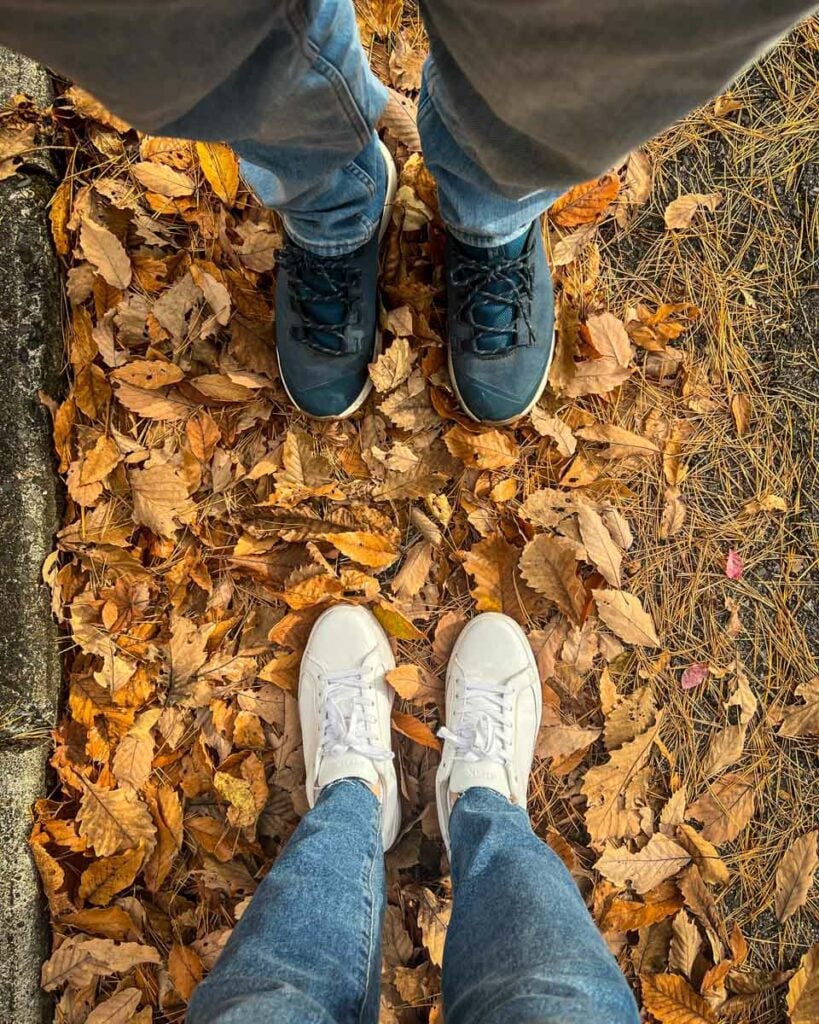
They aren’t exactly cheap but oh my goodness, they were game changers:
- They’re super comfortable: We walked more than 20,000 steps several days on our trip, and these shoes were great!
- We could literally just slip them on and off in an instant. This was the biggest selling point for me.
- They look nice: Japanese people tend to look very “put together” (including their footwear). I loved that these shoes actually look nice and are functional.
Ben was the most skeptical because he’s a frugal man at heart. But on the second day of our trip (after the 27th time taking them on and off), he leaned over to me and said,
“Okay, I’m glad you convinced me to get these shoes.”
I didn’t even rub in the fact that I WAS RIGHT because I was just happy that I didn’t have to wait for him to lace up his shoes for the next 3 weeks of our trip!
- Here is the pair I have: I love that I could wear them with pants and skirts – they really go with everything!
- This is the pair Ben has: It is sneaker-level comfort but has an elevated look. I also love this pair of men’s shoes that looks a little “dressier”.
I only share this because, just like Ben, I truly think you’ll love this suggestion. And I hope you think of me when you’re slipping your shoes on and off like a pro on your trip!
16. Nice socks
While we’re talking about feet… make sure you pack nice socks. Leave that ratty pair with the hole in the toes at home! (You know which ones I’m talking about!)
They don’t have to be anything fancy, but since you’ll be removing your shoes often, you don’t want to expose old, holey socks. It’s kind of a cultural no-no.
Insider tip: Japan is a great place to get socks with fun prints as a souvenir (as long as your feet aren’t super large, as the sizes tend to be smaller than in Western countries).
Traveling in summer? You may also want to keep a pair of ankle socks in your daypack on days when you’ll be wearing sandals. This can be nice to put on if you go into a restaurant where shoes must be removed or in a temple setting.
17. Water bottle
Tap water is safe to drink in Japan, so you’ll want to fill up instead of wasting single use plastic bottles.
This bottle is insulated to keep it cold and has a built-in straw for easy drinking.
Psst! We have more ideas for how you can reduce single-use plastics on your travels.
18. Toiletries

Here’s the thing… any Japanese hotel you stay at – whether a budget-friendly capsule hotel or a high end ryokan – will provide basic toiletries, like shampoo, conditioner, razors, a comb, and often even more items.
It can be tempting to just use those instead of bringing your own toiletries. While you technically can do this, we recommend against it because it creates an incredible amount of single-use plastic waste. We think bringing our own toiletries is just a small thing we can do to lessen our footprint. And we encourage you to do the same if you can!
Alternatively, if you’re big into skincare, you may want to plan on buying full size products when you arrive in Japan as the country is known for amazing and affordable products.
I’d recommend doing some research before your trip and coming up with a plan for which items and brands you want to buy because it can be a little overwhelming. This way you can still turn down the single-use toiletries (and save plastic waste!), and you can bring home some amazing Japanese products.
Insider Tip: We pack our favorite toiletries in a bag like this one to make sure everything stays organized, which is important especially in pocket-sized bathrooms that are common in Tokyo.
19. Mosquito repellent
If you’re traveling to Japan during the summer, you’ll want to pack mosquito repellant as they can be quite bad in some areas.
20. Camera gear
(optional)
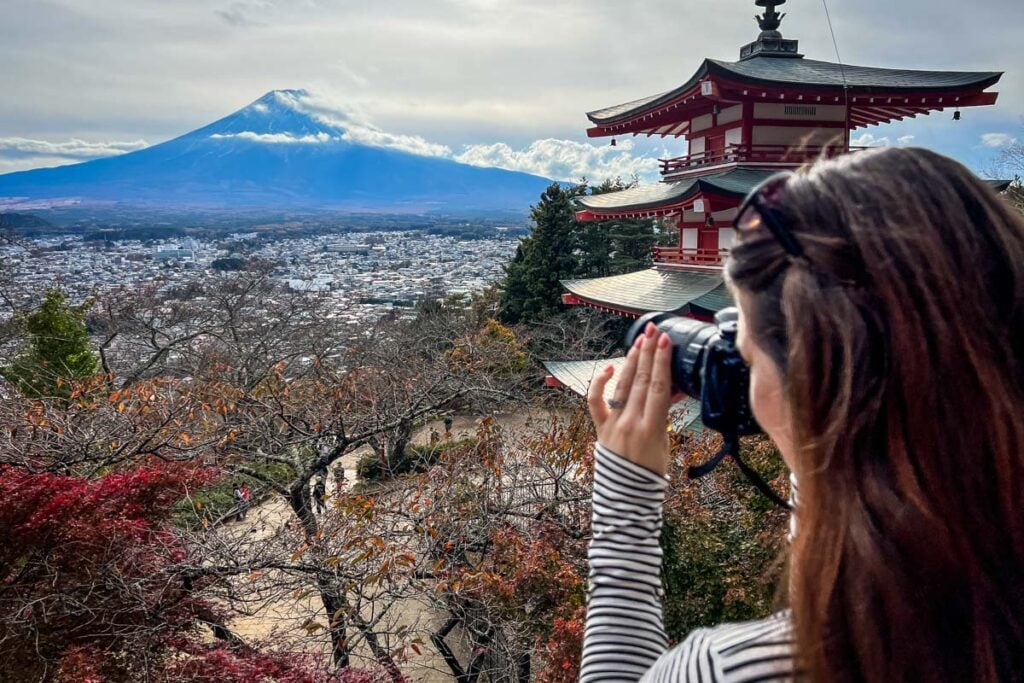
These days, smartphones are perfectly adequate for many travelers when it comes to taking photos. However, if you fancy yourself a photographer, you won’t want to miss out on bringing your equipment to Japan as there are so many photo opportunities around the country.
Be warned that the popular photo spots often have tons of crowds and it can be difficult to really set up a shot. However, if you like more unique locations or perspectives, you’ll love having your camera with you.
Our recommendation: You’ll likely want to bring a travel tripod as well as a lens cleaning pen or kit, for starters.
Psst! Before your trip, read up on our favorite travel photography tips.
21. Travel umbrella
(optional)

No matter what time of year you’re traveling to Japan, there’s a good chance you’ll encounter at least some rain on your trip.
Rain coats aren’t all that common in Japan because everyone – and I mean everyone! – uses umbrellas.
You can find umbrellas for sale (usually for pretty cheap) really easily, so if you don’t have one you like at home you could plan on picking one up in Japan.
However, if you already have one you like (this is our favorite travel umbrella), why not just pack it so you’re prepared and you don’t have to buy things you don’t actually need!
22. Eye mask

If you’re a light sleeper who needs the room to be pitch black in order to get a good night of shut eye, you will want to add an eye mask to your Japan packing list.
Many traditional ryokans and guesthouses feature shoji, or screens with a transparent paper, as room dividers. They are beautiful, but when placed in front of windows, they can let a lot of light in.
If you think this will bother you, pack an eye mask so you’re guaranteed a blackout room no matter where you sleep.
23. Hand sanitizer & handkerchief
As amazing as Japanese toilets are, we have been surprised to find that a lot of public restrooms in Japan don’t have soap dispensers or anything to dry your hands with.
We recommend bringing a small bottle of hand sanitizer so that you are able to freshen up after using public toilets. This is my personal favorite hand sani!
Some Japanese people carry a small towel with them for drying their hands in public restrooms, so you could bring one like this in your daypack if you’d like.
24. Bluetooth headphones
Having a pair of headphones is super handy on public transportation so you can use your phone without disturbing anyone.
Being on the Tokyo subway is kind of an interesting experience – they are often packed with people yet so quiet you could hear a pin drop. It’s almost uncomfortable having a conversation with your travel partner because people just don’t really talk on public transport. This goes for long distance trains too.
If you plan to be on your phone to watch a show or just browse social media, you need to pack a pair of headphones so you don’t disturb others.
This pair of bluetooth headphones is inexpensive and has great reviews.
25. Kindle
Having a Kindle loaded with books is a great way to stay entertained on long haul train rides (and your flight to Japan).
While we love physical books, nothing can beat how lightweight Kindles are. Plus, you can load it with a bunch of Japan books so you learn more about the country and culture in which you’re traveling.
Books about (or set in) Japan:
- Rice Noodle Fish
- Memoirs of a Geisha
- Hitching Rides with Buddha
- Pachinko
- A Tale for the Time Being
- Strange Weather in Tokyo
- Lost Japan
- Convenience Store Woman
26. Crossbody bag or small daypack
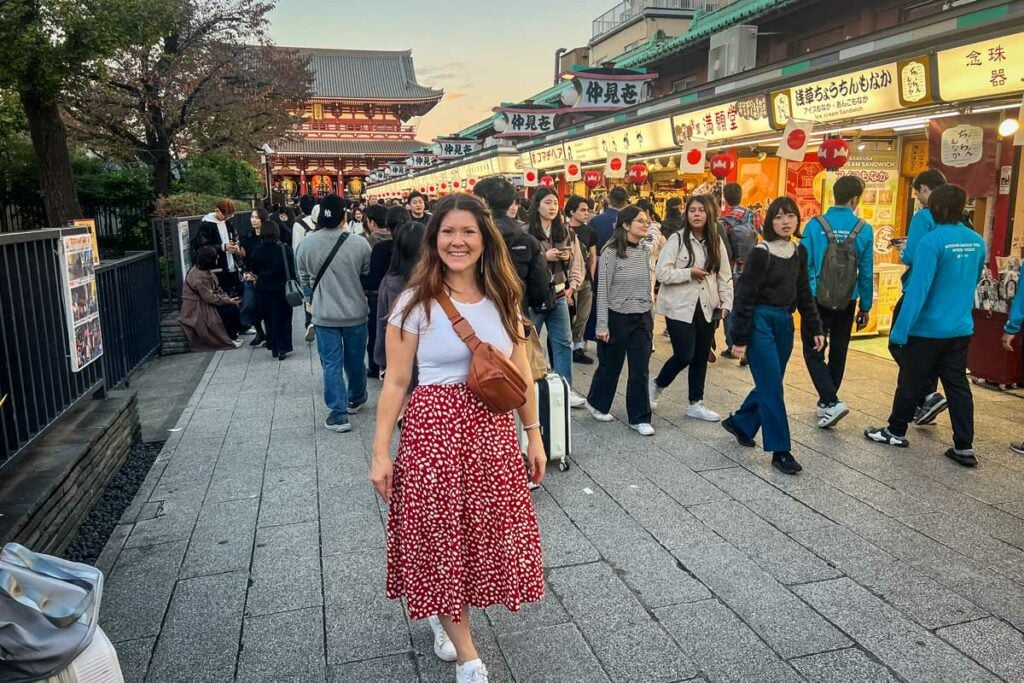
Don’t forget to pack a bag that you’ll carry during your day outings.
If you’re anything like us, there will be several days where you’re away from your hotel from morning until after dinner.
You’ll want something large enough to carry a water bottle, snacks, and other essentials; but you don’t want it to be so large that it gets in the way on public transport or in crowded places.
27. Sunscreen & sunglasses
Bring sun protection for when you’re out and about!
While you can find sunscreen in drugstores in Japan, a lot of it has skin lighteners in it, so we much prefer bringing our own from home.
These are my personal favorite sunglasses!
28. Hair clip

A large claw clip is essential for people with long hair (like me!) when bathing in an onsen.
It is considered unsanitary for your hair to touch the water, so a claw clip is the perfect solution for easily holding it up and out of the way.
29. Healthy snacks
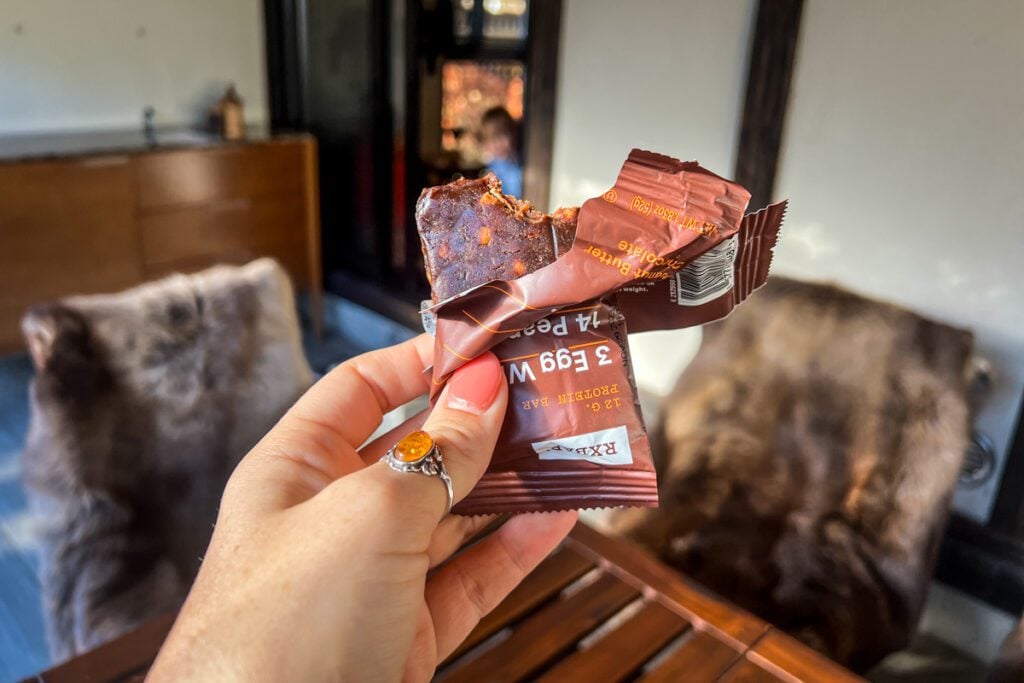
Avoid getting hangry by packing some of your favorite healthy snacks from home.
What about picking up snacks from Japanese convenience stores?
Good question! I love konbini (convenience stores) as much as the next person, but in my opinion, there’s a real lack of healthy, shelf-stable protein-packed options.
You’ll find things like onigiri, chips, hard boiled eggs, and candy easily. But if you’re like me and want something a little healthier when the hanger starts to strike, I recommend bringing a small stash from home.
Here’s what we packed:
- RX Bars (or similar)
- Nuts
- Dried fruit (without added sugar)
Good to know: You cannot bring dried meat, like beef jerky, into Japan.
30. Aeropress
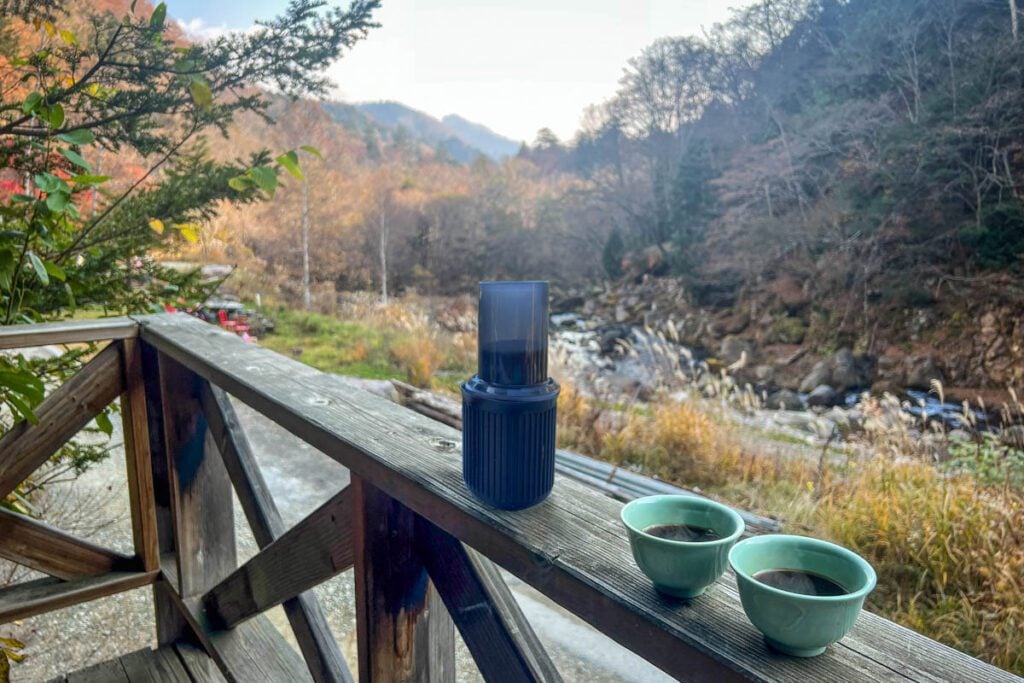
If you’re a coffee-lover like us, don’t sleep on this item!
While Japan’s coffee scene is quickly growing in popularity and you can find some excellent cafes around the country, many don’t open until 10 a.m. or even later.
If you like to start your morning with a caffeine boost, it can be hard to find a coffee shop that is open early.
Our personal experience: With the exception of one hotel and one Airbnb on our most recent trip, no other accommodations had coffee makers. We were so happy we packed our travel Aeropress because it got lots of use on this trip!
31. Jet lag pills
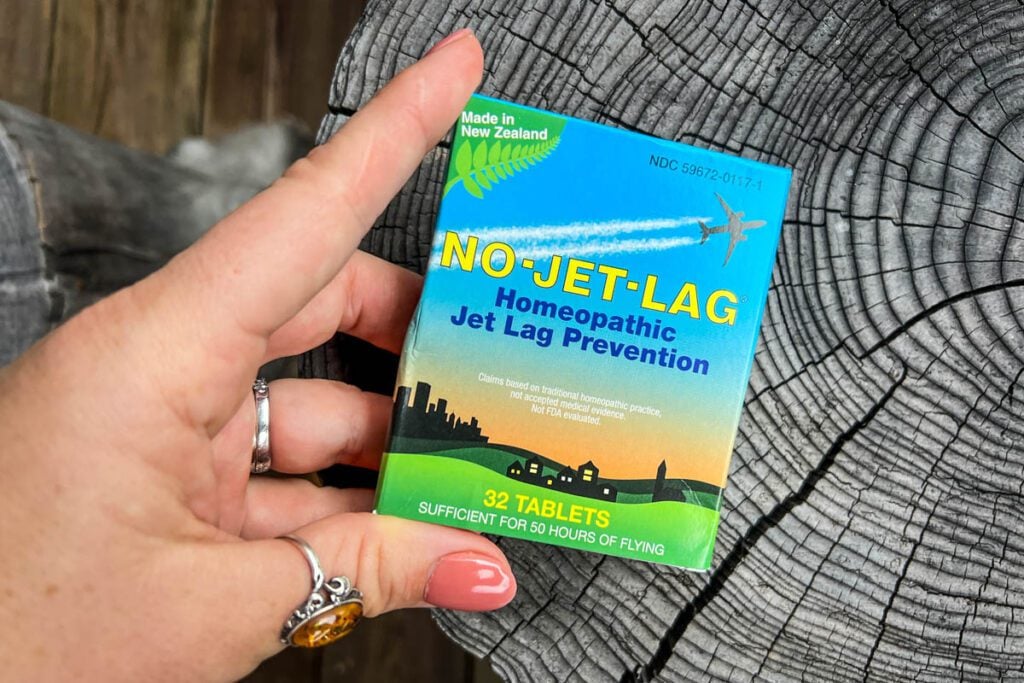
If you are flying from afar (like the United States or Europe), we recommend bringing these homeopathic jet lag pills. Follow the instructions and take them every two hours on your flight to lessen the effects of jet lag.
We’ve been using these for a couple of years now and while they don’t completely eliminate jet lag, we think they definitely help!
→ Psst! These game-changing tips to combat jet lag will help you adjust faster.
32. Small microfiber towel
(optional)

All hotels will provide towels, but if you plan to visit a lot of onsen during your trip, you may want to bring a small quick-drying towel for this purpose.
All major onsen will have towels available, but you typically have to pay to rent them. If this is something you’ll only be doing once or twice, it won’t be a big deal. However, if you plan to visit several, it can add up.
Additionally, if you want to go to any countryside onsen that isn’t developed (more like a hot spring), you will want to have your own towel so you don’t have to drip dry naked!
33. Prescription medication & first aid
This should be kind of an obvious one, but be sure to pack any medication you normally take (whether prescription or otherwise).
While you can find common meds in a Japanese pharmacy, it’s better to be prepared so you don’t have to go out and search when you’re feeling under the weather. Plus, you’ll know how much to take and how your body reacts to the type of medication you use at home.
There is an important asterisk here… Japan has pretty strict regulations when it comes to some medications that are over-the-counter in other countries. Some of the meds you’ll need to be wary about bringing include inhalers as well as some allergy and sinus medications.
Read up on the details so you know what medications you’re not allowed to bring in Japan, and what amounts of each are deemed acceptable.
34. Immunity boosters
While we’re talking about medicine, we typically like to bring some vitamin C tabs or spray, or other immunity boosters when traveling (especially when really long haul flights are involved).
In the couple days leading up to our flight, we like to grab some immunity shots (like these) from the grocery store to help give our systems a little boost.
35. Blister bandages
You’ll be doing a lot of walking in Japan – trust us – so you will want to be sure you have blister care packed.
Bring a sheet of moleskin (and a way to cut it) or blister bandages to prevent painful feet.
36. Menstrual products
It’s a good idea to bring your favorite menstrual products (pads, tampons, menstrual cup, etc.) from home as they can be hard to find in Japan (especially tampons).
37. Deodorant
Good deodorant is very difficult to find throughout much of Asia. This includes Japan.
We use only natural deodorant (and are pretty particular about the type), so we always try to bring enough for our entire trip.
On our most recent visit to Japan, we nearly ran out of deodorant and ended up buying the only stick we could find from a pharmacy. Spoiler alert: We did not like it, and it wound up in the trash after our trip.
Learn from our mistake: If you wear deodorant, bring enough for your whole stay in Japan.
38. Travel size stain remover
In general, Japanese people pride themselves on looking put together. Don’t let a stain from slurping ramen on day 1 ruin your wardrobe for the remainder of your trip.
We always travel with a Tide pen for easily fixing stains on the go. This is especially important when traveling with a toddler (if you know, you know!).
Lately, we’ve also been packing a small travel-sized squeeze bottle which we fill with Puracy, our favorite all-natural stain remover that I swear always gets the stain out! We keep this in our toiletry case in case the Tide pen doesn’t do the trick and we need extra power!
39. Bike shorts for under skirts

Long, flowy skirts are very popular with women in Japan and make a great choice for wearing in most seasons. They are comfortable and can be dressed up or down.
If you plan to wear skirts during your trip, I’d highly recommend also packing a pair of compression or bike shorts to wear underneath. You’ll be walking a lot and this will prevent chafing. Plus, it’ll feel more comfortable when you’re sitting on public transport.
These are my all-time favorite (affordable) bike shorts!
Hot tip: If you plan to visit teamLab Planets or Borderless and will be wearing a skirt, you’ll definitely want to wear bike shorts underneath because there are mirrors on many of the floors so people will be able to see up your skirt. There are shorts you can borrow free of charge, but it’s a lot more comfortable to have your own.
40. Laundry bag
One thing a lot of first-time travelers to Japan don’t know is that many hotels have laundry facilities, making it super easy to do a load of washing on your trip. This means you can pack lighter, which is a huge win!
We also always pack a laundry bag to keep our dirty clothes separate from our clean ones.
Optional: Laundry detergent sheets
Now, here’s something important to know: Many washing machines in Japan actually have detergent built into the cycle or detergent for sale.
However, if you’re sensitive to scents or just want to be sure you have detergent (a good idea if you’ll be staying at an Airbnb), bringing a few sheets of laundry detergent can be a good idea. It takes virtually no space, after all. These are the laundry sheets we use and bring on most of our trips.
That said, this won’t be for everyone. If you know your itinerary is packed and you really can’t see yourself doing laundry on your trip, skip this one!
41. Air Tags
(optional)
If you plan to use a luggage transfer service in Japan, we recommend placing an Air Tag in each suitcase you will have transferred. This will allow you to keep an eye on your luggage and see where it is en route to your hotel.
Jump here to learn more about the luggage transfer service.
42. Stuffable shopping tote bag
We always travel with a stuffable tote bag for the inevitable souvenir or snack purchases.
This one packs up super small and makes it easy to refuse single-use plastic bags.
43. Small gifts from home (omiyage)
(optional)

This is purely optional, and isn’t something we have ever personally packed on our trips to Japan. However, we might do so in the future.
Omiyage is the Japanese word meaning “small gift, or souvenir”. More specifically, omiyage are local or regional products that represent a place. It is customary for Japanese people to pick up these small gifts (often food items) on their travels to give to their friends, family, and colleagues.
Some travelers choose to bring some small items that represent their home country to give to people they meet in Japan. It is not at all expected that you travel with omiyage, and with the exception of a couple of experiences, we haven’t felt like it would have been necessary or even appropriate to give something.
That said, if you know you will be interacting with local people or have special experiences booked, you may choose to bring something.
On our most recent trip to Japan, we dined with a local family in Tokyo through a program called Nagomi Visit (highly recommend this experience!). It was such a wonderful evening connecting with this Japanese couple and we would have loved to return their kindness with a small gift. There were also a couple of guest house hosts that were especially kind to our daughter who we would have liked to thank with a small gift.
If you choose to bring omiyage, make sure they are small and don’t easily break. You probably only need a few.
Some ideas are:
- Candy, snack, or food item from your home country (individually wrapped)
- Trader Joe’s spices or reusable bags (apparently these are a hot commodity in Japan!)
- Small magnet, pencil, pin, eraser that represents your home
Traveling with a baby or toddler?
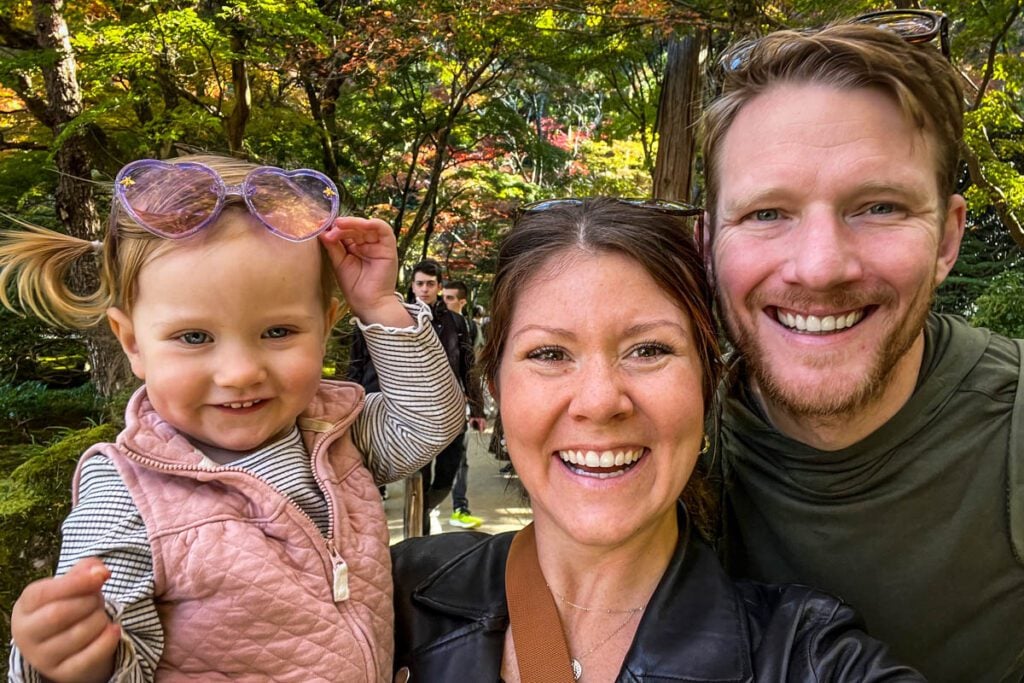
We have a whole guide on traveling in Japan with children (including a packing list!), but here are some items you definitely don’t want to forget:
44. Nursing cover
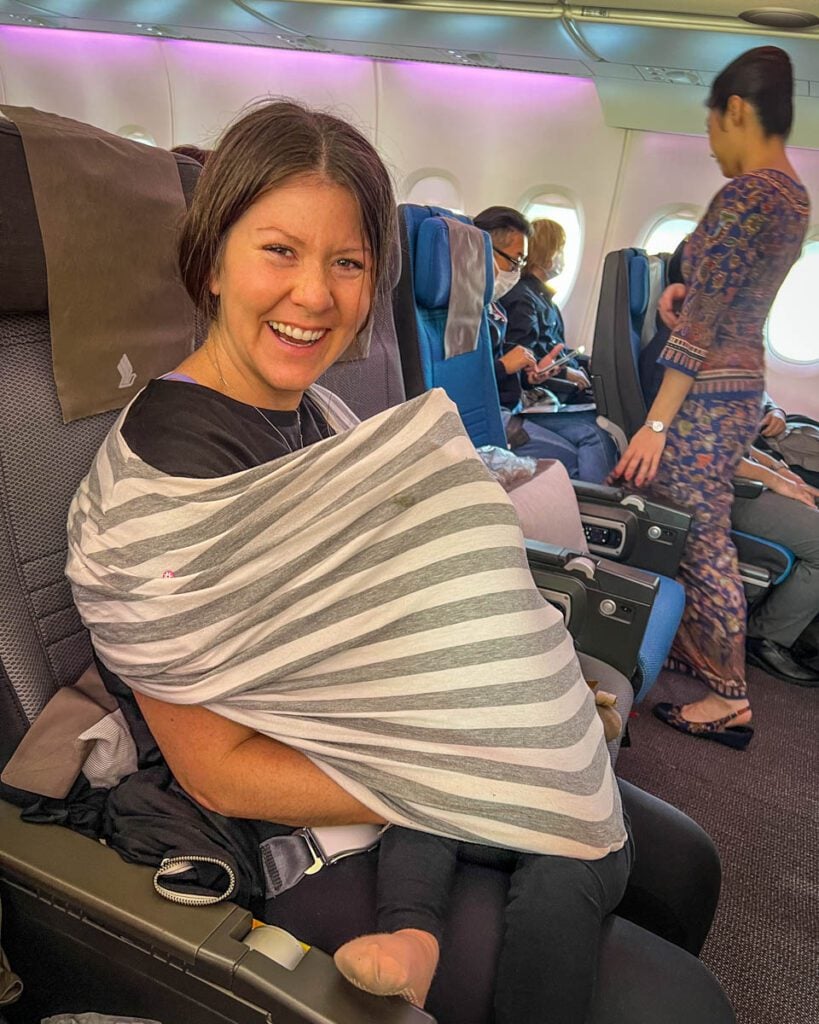
If you’re breastfeeding, you’ll want to be sure to pack a nursing cover (even if you don’t use one at home). Many mothers in Japan breastfeed their children, however, doing so in public without a cover isn’t something you’ll often see.
In big cities, like Tokyo and Osaka, you’ll see nursing rooms at train stations and such, but outside of these areas it can be hard to find a place to nurse in private. So for these situations, you’ll definitely want to bring a nursing cover.
45. Compact stroller

If you have a young child, you’ll definitely want to bring a stroller to Japan.
It’s especially helpful when you’re exploring big cities and aren’t able to get back to your hotel for nap time. If your little one can sleep in the stroller you’ve bought yourself lots more time to see the city.
If your stroller has a basket on the bottom it can be a great way to carry things throughout the city, too.
We have this super compact travel stroller that we love. It worked really well for our trip to Japan, and we’d highly recommend it.
Insider tip: While strollers are essential for traveling in Tokyo with a baby or toddler, it’s not without its struggles. To make getting through the subway easier, use the “wheelchair accessible” filter on Google Maps so that you get directions to the nearest elevators. That said, know that you’ll likely still have to carry it up and down a few stairs or up escalators at some point.
46. Baby carrier
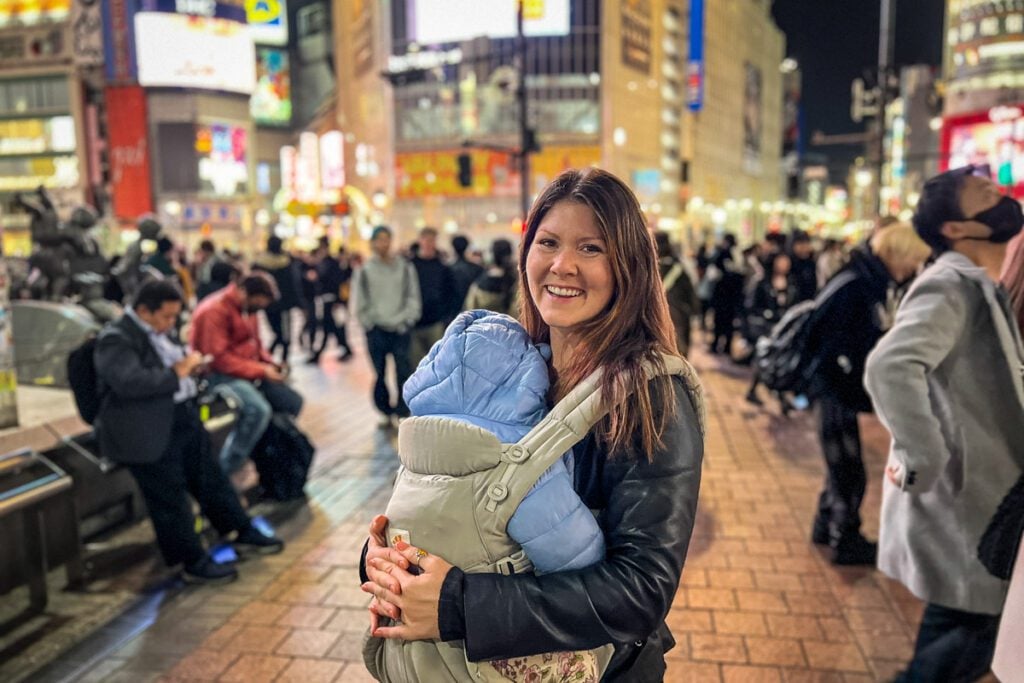
While we think a stroller is essential, there are certainly some places and activities where a baby carrier is much easier.
For instance, if you plan to walk the Nakasendo Trail (highly recommend!), a baby carrier works great! We brought our daughter – who was about 2 years old at the time – on this trail and this carrier was great.
47. Toddler snacks

If you’re traveling with a young child, I personally recommend bringing a decent amount of your favorite snacks from home. This isn’t to say you can’t find snacks for your baby or toddler in Japan – you certainly can – but I personally didn’t find there to be as many healthy options as I was hoping.
At convenience stores, you can get bananas, hard boiled eggs, onigiri, and yogurt. At supermarkets, you can find a bit more variety and there is a “baby” section, however I found the things like crackers, pouches, and yogurt have lots of sugar and other ingredients I’m not crazy about.

So to balance things out, I was happy I brought some of our favorite snacks from home:
- Pouches (the ones we got in Japan were a jelly-like texture instead of a fruit puree, and they had a lot of sugar added)
- Mama Chia pouches are one of our favorites (we get them at Costco)
- Justin’s almond butter packets
- Date & almond butter bars from Trader Joe’s
- Freeze dried strawberries
- Smoothie melts
- Simple Mills seed flour crackers & sweet thins
- DIY oatmeal mix
- Outside of your hotel, it can be difficult to find breakfast options in some areas, especially Western-style breakfast (and even more so early in the morning).
- We brought a large bag of oatmeal mix from home (oats + coconut milk powder + chia seeds + freeze dried fruits + cinnamon + powdered peanut butter + a little bit of coconut sugar).
- Anytime our daughter got hungry, we just needed to add a little bit of water, which was super simple!
Of course, she ate all sorts of food on our trip too, but it was nice to have some easy snacks on hand.
48. Diaper bag fanny pack

When I saw this diaper fanny pack I was a little hesitant (because it ain’t cheap!), but I went ahead and splurged before our Japan trip and I’m so happy I did. It made changing diapers on the plane a breeze, and I wore it each day instead of a purse.
It’s super cute and goes with everything and nothing about it screams “diaper bag”! I love that it made it easy to bring only what we needed each day instead of lugging around a backpack.
Tip: Make sure you add on the belt extended at checkout (it’s free but you have to physically add it to your cart). You need this in order to wear it like a crossbody bag, which is how I prefer to wear it.
Renting a car in Japan?

If you’re planning on making your visit a road trip (yay – we have a whole guide to renting a car in Japan!), there are a few specific items you don’t want to forget.
Insider Tip: Measure your luggage to ensure it will fit in the car you are renting. Many of the cars in Japan have incredibly tight space in the trunk.
49. International Drivers Permit

All foreigners who want to rent a car in Japan will need an International Drivers Permit. Period. You can’t rent a car without this.
50. Phone mount
(optional)
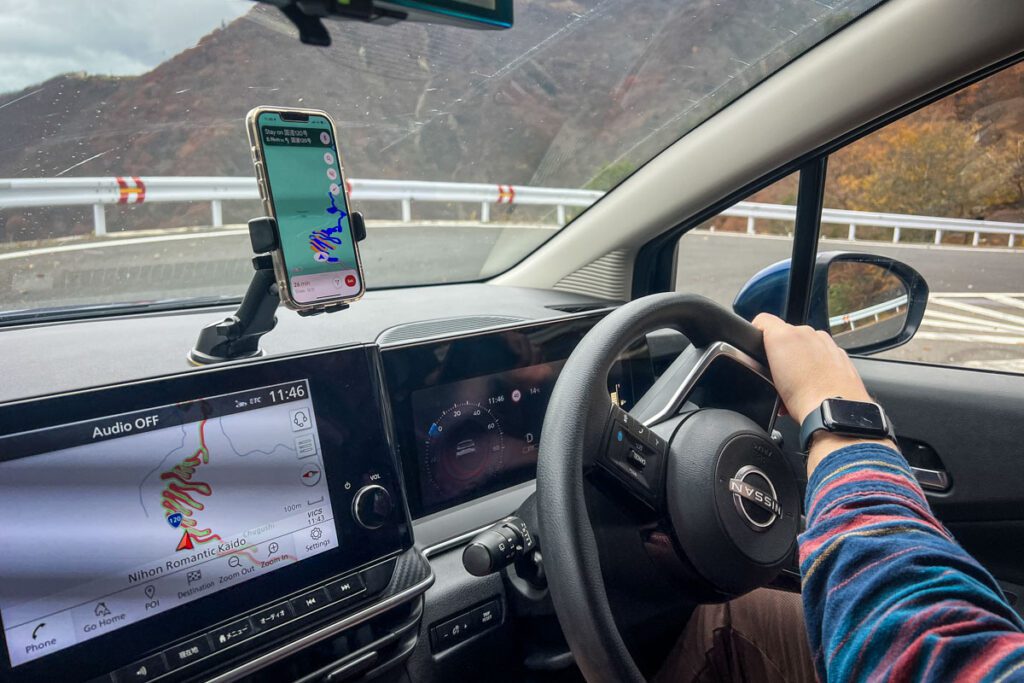
Most cars in Japan have the capability to connect your phone to a screen where a map and directions show up.
If you prefer to see directions on your phone (instead of relying on whatever set up the car has), you can pack a mount for your phone.
51. Car window screen
(optional)

If you are traveling with a child, we recommend bringing a window sock like this one to keep the sunlight out of their eyes.
Our personal advice: We like this type of window covering because it packs up really small and doesn’t leave gaps in the window where sun gets in. That said, it darkens the window and takes a bit of getting used to so we recommend driving with it at home for a few days first to see if it’ll work for you.
Skiing in Japan?
Planning a winter trip to experience the famed Ja-Pow?! Don’t forget your winter gear essentials!
52. Ski gear and outerwear
If you are only planning to ski one day and you’re not die hard, you may get by just fine with rentals. Just be sure you know what outerwear is available to rent (ie. snowpants, winter jacket, mittens, helmet, etc.), as well as what sizes are available. You may decide to do a mix of bringing some from home as well as using rentals.
Alternatively, if this will be a big ski trip for you, start gathering the essential gear you’ll need as well as the proper luggage to transport it all.
Insider Tip: If you’re bringing your own skis or board, you’ll likely want to utilize a luggage transportation service so you don’t have to lug all your gear on the trains and public transport.
What NOT to pack

Here are a few things you can leave out of your suitcase:
Too many things for the flight
I understand that many people will be flying great distances to get to Japan and you want to be prepared to have a comfortable flight. However, I’d highly recommend against packing a ton of stuff that will only be useful on the airplane, like a neck pillow, headphone adapters, foot hammocks, etc.
The flight is such a short portion of your trip and personally, I’d rather save room for essentials and souvenirs to bring home. Plus, have I mentioned how important it is to pack light?! Instead, pack things like mints, lip balm, hand sanitizer, moisturizer, etc. in a small bag so they’re easily accessible on the flight (aka an “airplane kit” if you will).
→ Related: Feel prepared for your next long haul flight. Here’s the carry-on essentials we never fly without.
Slippers
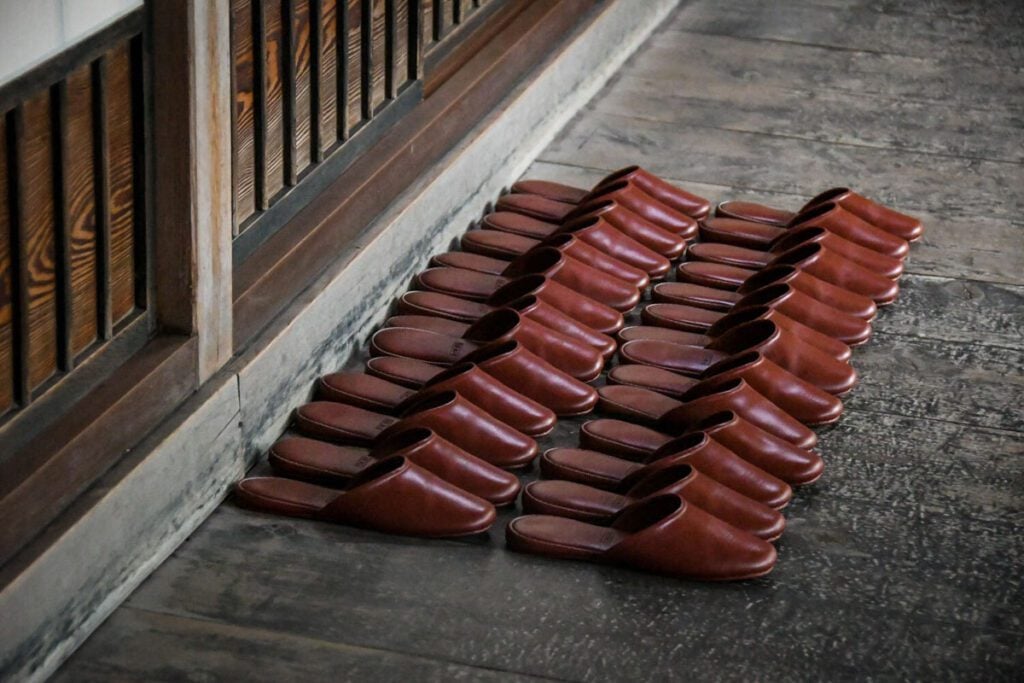
All hotels in Japan have slippers or indoor shoes. We packed our travel slippers on our most recent trip to Japan (because we wanted them at our next destination), but they didn’t get any use in Japan since we had them at each accommodation.
Drone
Drones are widely banned throughout Japan. If you really want to bring it, read up on the (very strict) regulations here.
We’ve packed ours on two Japan trips (as we were traveling to more destinations both times), but we were only able to use it once, in the middle of a multi-day hike in the wilderness. Every other place we considered taking it out had signs banning drones.
If you choose to bring a drone, know that you may not ever get to use it (that was the case on our most recent trip). And respect the rules. Never use it in areas where it is not allowed.
Large towel
All hotels will provide a towel so you don’t need to worry about bringing your own. The exception to this is if you plan to visit a lot of onsens during your trip and don’t want to have to rent them each time, you could pack a small quick-dry towel.
Swimsuit

When soaking in onsen in Japan, it is considered unsanitary to wear a bathing suit, so you must soak naked. I have seen some undeveloped onsen (like a hot spring) in which bathing suits are allowed, but these are very few and far between.
If you’re staying at a hotel with an actual pool or going to the beach, this is different, but you won’t need a bathing suit for most trips to Japan.
Revealing clothing
I’m all for dressing in a way that makes you feel comfortable. However, I’d personally recommend avoiding low cut tops and tight clothing because it will attract unwanted attention.
Shoes that aren’t comfortable for walking
I’m starting to sound like a broken record, but you’ll be walking a ton. Put extra thought into the shoes you pack and only bring ones you’ll feel comfortable walking in all day long!
Perfume
It isn’t common for Japanese people to wear fragrances. I’d recommend not wearing perfume or cologne when you know you’ll be in crowded places, like the subway in Tokyo (or just leaving it at home).
It’s also frowned upon to wear fragrance when you’re dining because it can interfere with your eating experience (as well as those around you). This is especially important in sushi restaurants and higher-end dining in Japan.
Alternative: An essential oil roller can be a good compromise as a way to freshen up without the scent being too strong. Even so, try not to do this before dining or using crowded public transportation.
Packing tips for Japan

When you are packing for your trip to Japan, keep these tips in mind:
1. Pack light
I’ll say it once, I’ll say it again… Pack as light as possible! You’ll be carrying your luggage in and out of trains, on subways, and through city streets. Imagine doing that with huge suitcases and duffle bags. It will put a huge damper on your trip.
Pack the essentials, plan to do laundry, and know that you can buy many things in Japan (if you feel like you forgot something).
2. Know about luggage transfer service

This service can be great for some travelers, but be sure you fully understand how it works before you count on it…
There are luggage transfer companies in Japan that make it possible to have your suitcases transported for you so you don’t have to bring it on subways or on trains.
There are 2 ways they do this:
- Same-day, same city transfer: This is helpful if you arrive in a city and don’t want to bring your suitcases all the way to your hotel. You can drop the luggage off at a transfer counter at the airport or train station and they can transport your suitcase within the city that day.
- Next-day, different city transfer: If you are traveling between cities in Japan, these transfer services can bring your luggage from one city to the next. The catch is that it won’t arrive until at least the next day. Also, this service is only available between the larger cities in Japan, so it won’t be possible everywhere.
Our experience: Personally, we’ve never used this service because we had a more off-the-beaten-path itinerary so the transfer service wasn’t available to these places. Also, we didn’t like the idea of parting with our bags for an entire day. Packing all our clothes and items for the day/night seemed like a lot more work than it was worth. We purposely packed light to begin with so that we didn’t feel the need to rely on this service. Sure, there were a couple of times it would have been helpful, but overall, we think packing light is a better plan.
3. Leave room for souvenirs

Japan is one of my favorite places in the world to buy souvenirs from. There are truly so many special things you can bring home, whether it be a handmade fan, your own set of chopsticks, clothing, spices, a Japanese chef knife, artwork, ceramics, matcha, a kimono… I could go on and on and on.
In fact, I already did in our guide to the best things to buy in Japan.
My point is that you will definitely want to get some souvenirs. Don’t pack your suitcase so full that you don’t have room to bring anything home with you.
Some travelers even bring a duffle bag squished down that they can expand to hold all the souvenirs they buy. In theory, it is a good idea, but personally, I don’t love this because you end up having another entire bag to carry around with you. I’d rather pack extra light and fill the empty space with my new finds!
4. Bring only comfortable walking shoes
I cannot stress enough the importance of packing only comfortable shoes.
You will regret bringing that cute pair that just isn’t all that comfortable. Save your feet and the space in your suitcase and leave them at home!
Plan your trip to Japan
After 3 trips (and counting!), we’ve fallen head over heels for Japan—and we’ve created TONS of resources to help you plan your dream trip. Start with our Ultimate Japan Travel Guide and be sure to check out these helpful articles:
- First time? Our Japan Trip Planner walks you through everything you need to know.
- Use our Japan Rail Pass guide to determine if getting a train pass is optimal for your trip.
- Here’s our curated list of the best things to do in Japan—from iconic sights to once-in-a-lifetime experiences.
- Not sure where to go? Our Japan itinerary ideas will help you map it all out.
- Foodies, rejoice! This guide to what to eat in Japan will have you drooling before you land.
- This guide to what to wear in Japan (and what not to wear) will help you blend in.
- Before you go, brush up on these essential Japan travel tips (including major do’s and don’ts!).
- Avoid awkward moments by brushing up on Japanese etiquette.
Still have questions? Drop us a comment—we LOVE helping travelers plan unforgettable trips to Japan!
Perfect Japan itinerary
Want the perfect itinerary planned for you?

If you don’t have a ton of time to spend planning your Japan itinerary (or you just don’t find travel planning fun), we’ve got something you might be interested in…
We created the ultimate done-for-you Japan itinerary that is packed full of all sorts of tips we’ve gathered from 3 trips to Japan as well as literally hundreds of hours of research (no exaggeration).
We have both an off-the-beaten path route as well as a classic itinerary that hits the top attractions (perfect for your first visit to Japan!).
Don’t miss your chance to grab our Japan packing list!
This FREE PDF download includes everything you’re going to want to pack for your Japan trip, including what NOT to bring, plus tons of insider tips!
Just enter your email and we’ll immediately send you access instructions!
Save this article on Pinterest for later!

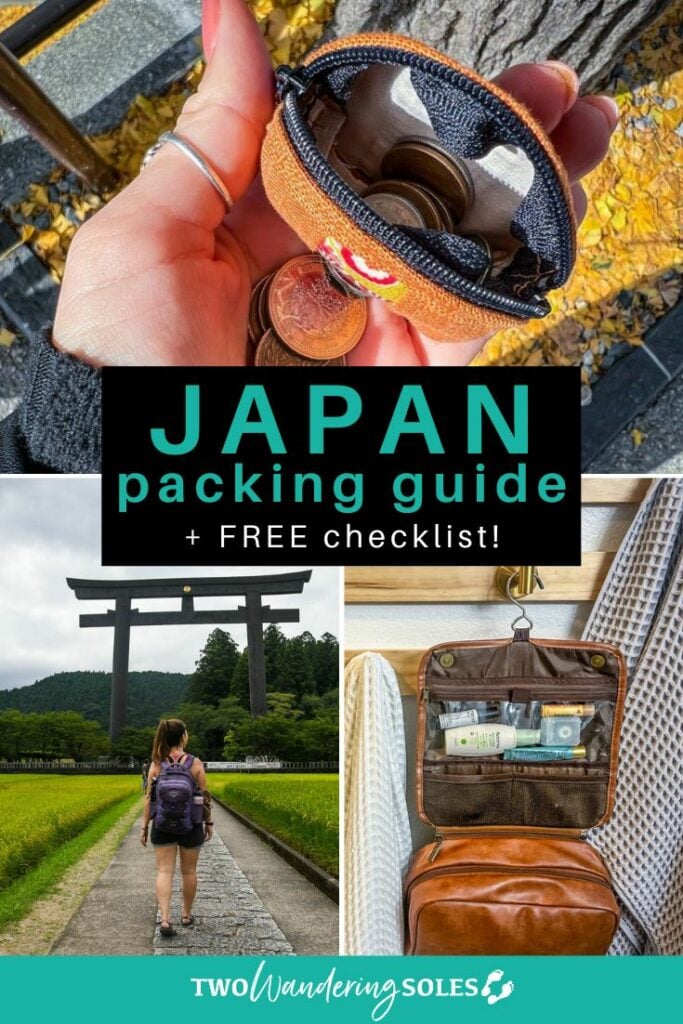
We want to hear from you!
Do you still have questions about what to pack for Japan after reading this article? What are some items you never travel without? Leave us a comment below and we’ll do our best to get back to you!

